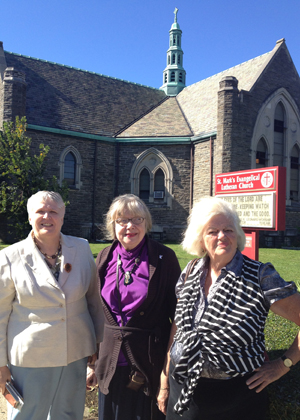 The Ambassadors attended this church in the Oak Lane neighborhood of Philadelphia. It was a return trip for one of the Ambassadors who attended this church 30 years ago.
The Ambassadors attended this church in the Oak Lane neighborhood of Philadelphia. It was a return trip for one of the Ambassadors who attended this church 30 years ago.
The service was part of a long day for St. Mark’s with fellowship and education beginning at 9:30. The service began at 11 and was close to two hours in duration with more fellowship afterwards. Afternoon obligations forced us to leave before the Eucharist, but we enjoyed the spirit and wealth of music.
Attendance at the beginning of the service was about 40 but within a half hour the numbers swelled to about 60. About a quarter included children and youth which was refreshing and rare.
Pastor Leonard’s sermon talked about the temptations that ambition and power present to ministry, tying it to Mark’s account of the disciples vying for importance. Once again, we saw a disconnect between what is preached and what is practiced. The conflict SEPA congregations have with Redeemer is fueled almost solely by greed for our property and the need to prevail in power. We note that Rev. Leonard has served on Synod Council for much of the duration of this conflict and has been in a position to influence and temper the conflict without success. In his sermon, he even talked about bishops who covet the position for the status and money. It was all we could do to refrain from shouting AMEN!
The service included lots of hymns. A lengthy opening praise section was led by a praise team. The hymns were many of Redeemer’s favorites. A portable mic was passed among the congregation so that many congregants could participate and be heard. A new liturgy was used, peppered with warhorse hymns from Fanny Crosby’s Blessed Assurance to the Gospel hymn, Lead Me, Guide Me — the favorite hymn of a Redeemer member who died shortly after the lockout. One Ambassador commented that she enjoyed the drum accompaniment to all the hymns.
The sanctuary is beautiful and well-kept and was a pleasant place to spend this cool autumn Sabbath.
We noted that they do not have a web site listed in the synod records but opened a one-post blog in July. We encourage them to expand on that platform. We’ve had great responses from our blog!



